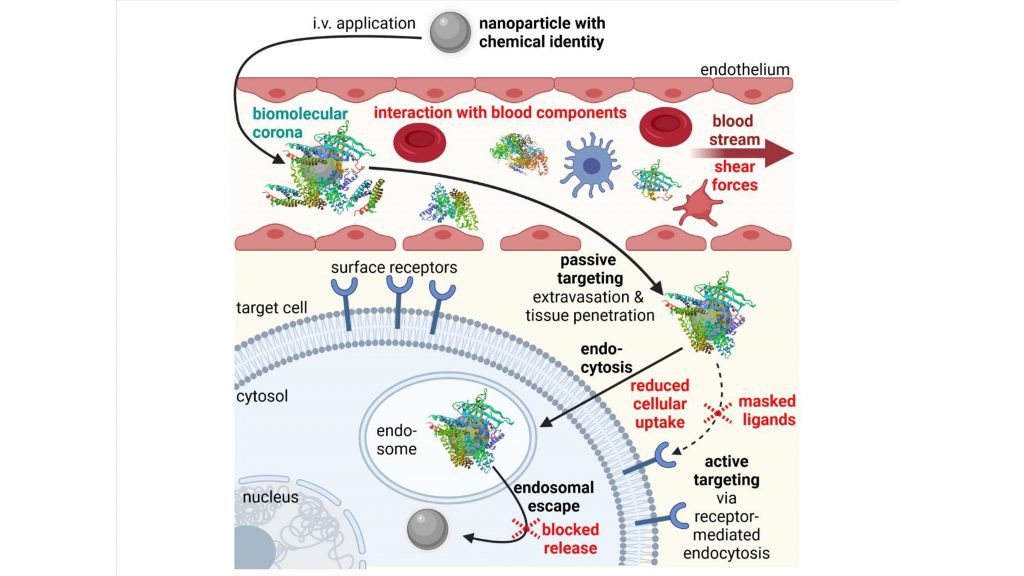From the Journal: Biophysics Reviews
WASHINGTON, February 1, 2022 — Messenger RNA (mRNA) vaccines are a prime example of the promising field of nanomedicine. But progress in the design and application of nanoparticles as efficient delivery vehicles for biopharmaceutics containing nucleic acid or protein drug substances is, unfortunately, remarkably slow.

CREDIT: Simone Berger, Martin Berger, Christoph Bantz, Michael Maskos, and Ernst Wagner
One recent obstacle to drug delivery research is an observed weak correlation between in vitro (outside a living organism) and in vivo (inside a living organism) performance. This problem was not clear in early stages, when cellular delivery of a drug nanocarrier was tested primarily within standard cell culture. With advanced pharmacological in vivo studies emerging in mice or human patients, the low reliability and validity of cell culture testing for therapeutic applications is becoming apparent.
When nanoparticles are applied intravenously, they face several obstacles that differ from in vitro situations, such as when they meet blood components. Nanoparticles are usually covered by a biomolecular multilayer (a protein corona), which alters the physiochemical properties, pharmacokinetics, and toxicity profile of the nanoparticles.
In Biophysics Reviews, from AIP Publishing, researchers in Germany provide a cutting-edge characterization of the protein corona formed around nanoparticles and its impact on the physiochemical and biological properties of these nanoparticles.
“When predicting in vivo performance from in vitro data, it is recommended to combine several analytical and biological characterization methods to get more detailed insight into the in vivo characteristics and behavior of the nanoparticles,” said Simone Berger, a co-author from Ludwig Maximilian University of Munich.
The choice of the biofluid — serum, plasma, or full blood, and animal in origin — and establishment of standardized protocols are of great importance for more consistent, robust, and comprehensive preclinical studies to derive structure-activity relationships and in vitro/in vivo correlations.
“The knowledge gained about protein corona formation can be exploited to optimize carriers for nanomedical application,” Berger said.
Information like in vivo biodistribution and off-target effects cannot be obtained from in vitro experiments, the researchers point out. But new high-throughput screening methods like the barcoding system can make in vivo investigations more effective, economical, and ethical.
Some uncertainty remains about translatability from small to large animals and humans, but bioinformatics could help identify best-fitting animal models for certain diseases.
“Alternatives to animal models, such as microfluidic ‘human-organ-on-a-chip’ technology or computational predictions, may be promising strategies for replacing animal studies in the future,” Berger said.
Nanomedicine shows “great potential to revolutionize the therapeutic landscape with a broad range of applications like cancer vaccines/immunotherapy or treatment of genetic disorders,” said Berger. “With proper and more predictive in vitro assays, the preclinical pipeline will become more efficient, faster, and economic. And importantly, animal experiments can be replaced or at least reduced.”
###
For more information:
Larry Frum
media@aip.org
301-209-3090
Article Title
Performance of nanoparticles for biomedical applications: The in vitro/in vivo discrepancy
Authors
Simone Berger, Martin Berger, Christoph Bantz, Michael Maskos, and Ernst Wagner
Author Affiliations
Ludwig Maximilian University of Munich, Johannes Gutenberg-Universität Mainz, and Fraunhofer Institute for Microengineering and Microsystems IMM
